The International Trade Blog International Sales & Marketing
The Essentials of Export Financing: International Finance Options
On: February 19, 2018 | By:  Curt Hanson |
14 min. read
Curt Hanson |
14 min. read
 While the idea of exporting your goods and services may seem a bit overwhelming to many small business owners, there is no doubt of the benefits. Approximately 95% of consumers live outside the United States, and in many economies of the world, there is a rapidly growing middle class.
While the idea of exporting your goods and services may seem a bit overwhelming to many small business owners, there is no doubt of the benefits. Approximately 95% of consumers live outside the United States, and in many economies of the world, there is a rapidly growing middle class.
Small- and medium-sized companies represent 97% of U.S. export companies, while small companies—those with 20 or fewer employees—represent about two-thirds. And yet, only about one percent of U.S. small businesses actually export their products. And half of those that do export to only one country.
As these facts can attest, there is a huge market to tap into, and there are a variety of strategies that small business exporters can follow to produce the desired results. That said, why would a typical small business want to start exporting or increase their current export activity?
There are good reasons on both a micro and macro level including:
- Extend product life cycle;
- Minimize cyclical or seasonal nature of your market;
- Develop a source of marginal revenue that both increases total revenues and decreases the fixed cost burden, which improves margins on domestic business;
- Create new jobs and new opportunities for existing employees; and
- Contribute to supporting the balance of trade.
So there are very good reasons why small businesses should export or expand their existing exports, and there a variety of ways of doing so. But that does not mean there aren't challenges to exporting that must be overcome, and one of the most significant of those challenges normally centers on trade finance.
Export Trade Financing
There are three key issues that fall under the umbrella of international trade finance:
- How does a company finance the production of goods destined for export, particularly if they are bumping up against their current credit limits?
- How do they determine what payment terms will make their product competitive in international markets, and how do they identify and deal with the related risks?
- When should they offer terms, and how do they do so without placing their balance sheet at risk or compromising their credit policies?
These questions can be addressed by pre-export finance programs to finance production destined for export, and post-export finance that addresses methods of payment, risk mitigation, and financing tools.
Pre-Export Working Capital
This change has produced a double whammy for U.S. exporters: export orders are up, but more clients are requesting terms; and most banks are not willing to provide financing to support the working capital needed to fulfill the new orders.
The U.S. government, through the Export-Import Bank (EXIM) and the Small Business Administration (SBA), has a long established program that was designed to specifically address the problem.
The Export Working Capital Program (EWCP) provides a 90% guarantee to the lender for working capital financing used to support export orders. That means a bank can lend an exporter significantly more money at significantly less risk due to the U.S. government guarantee, just what they are looking for in the current economic situation.
What Is the Export Working Capital Program?
The EWCP requires the lender to establish a separate line of credit that can be only used to support export orders. The line of credit can be transaction specific if the exporter produces large pieces of capital equipment with a long production cycle, or a revolving line of credit. It is an asset-based line so the lender advances against a collateral pool consisting of production destined for export and ultimately foreign account receivables.
From an exporter's perspective, the EWCP provides access to more capital through the entire cash cycle. This is because the EWCP allows the lender to apply higher advance rates to the loan collateral, and to include, as eligible, collateral that they would not normally advance against.
Advance rates for inventory can be as high as 100% for raw materials and 75% for work-in-process and finished goods destined for export. Advance rates for foreign accounts receivable are 90%.
In situations where the exporter is producing capital equipment, they may be able to negotiate a significant down payment and perhaps milestone payments during the production process. The foreign buyer, however, may require a performance bond in the form of a standby letter of credit as a means to recover their money if the exporter does not ship.
Under the EWCP, the collateral requirement for the performance bond is only 25%, so the exporter still has access to 75% of the cash payments to finance production.
The EWCP is also available to indirect exporters who may not be exporting their products directly. If their product is a component and their client is a domestic company that will be incorporating that component into a finished product and that product will be exported, then the company can qualify for the EWCP as an indirect exporter.
If you are exporting your products directly or if someone else is, the EWCP is an established program to give you access to more borrowing capacity through your entire cash cycle with your existing lender.
Export Terms of Trade
 One of the most important aspects of your export business is your terms of trade. You must have a clear understanding of the various methods of payment available including the costs, risks, marketing implications and, of course, when you will actually receive payment.
One of the most important aspects of your export business is your terms of trade. You must have a clear understanding of the various methods of payment available including the costs, risks, marketing implications and, of course, when you will actually receive payment.
It is also important to know that your terms of trade should not be one size fits all; you can and should offer different methods of payment based on the circumstances.
Cash in Advance
Cash in advance is the method of payment that will be preferred by your finance people. There is no payment risk, you get paid up front, and you can use your client's money to finance production of the product you're selling.
From your client's perspective this is the riskiest and one of the most expensive methods of payment. They have to give up use of their cash and have no assurance that you are actually going to ship them what they ordered.
The end result is very negative marketing implications for you. Still, this can be an acceptable payment method for small non-repetitive orders including sample sales.
Open Account Terms
Open account terms are the opposite end of the spectrum from cash in advance. You as the exporter must finance production with your own available resources and take all of the risks of getting paid.
From your client's perspective this is the preferred method of payment in terms of costs and risks, and it provides very positive marketing sizzle. There are tools that allow you to sell on open account terms without taking all of the non-payment risk including a standby letter of credit or credit insurance.
In today's global marketplace open account terms are becoming the norm and a competitive necessity for recurring sales, particularly to representatives and distributors that are creating a market for your products.
Documentary Collections
Documentary collections are a method of payment that actually involves using the banking channels for something more than handling the movement of funds for your payment. With a documentary collection you are relying on the bank to control your product until payment is made. This is accomplished by sending your invoice and bill of lading needed to claim your shipment through the banking channels along with a bank collection letter.
Your bank sends their collection letter with your documents to your client's bank. They contact your client and advise them to come in and make payment so they can release your documents to them. Your most significant risk is your buyer saying they changed their mind and no longer want the product that was shipped.
Documentary collection terms can be effective when you wish to have control of your product until it is paid for, and your client does not want to pay for your product until it arrives in port. This can be used effectively for sales to distributors that have the product sold and do not have to offer terms locally.
Letter of Credit
Documentary letters of credit are the method of payment where the banks are actively involved in shifting the payment risk and directly settling the payment. Because of this level of involvement, this is the most expensive method of payment for both the exporter and the importer, and it requires the importer to tie up their available credit with their bank.
The primary function of a letter of credit is to shift the credit risk of the importer to the issuing bank and, if deemed necessary by the exporter, shift the credit risk and the country risk of the issuing bank to a confirming bank.
Payment under a letter of credit is guaranteed by the issuing or confirming bank provided the exporter can comply with all of the requirements specified in the letter of credit, and provide all of the required documents in the manner specified. Because of the documentation risk and the costs, letters of credit are best suited to large non-repetitive transactions or transactions involving custom designed products.
Export Payment Risk Mitigation
 Today the most competitive payment term that minimizes banking charges and eliminates documentation risks is open account.
Today the most competitive payment term that minimizes banking charges and eliminates documentation risks is open account.
Open account terms are also the most effective way for an exporter to provide working capital support for representatives or distributors who are creating a market for their products. But what about the commercial and political risks of non-payment, and how do you finance those foreign accounts receivable?
Trade credit insurance allows an exporter to offer open account payment terms without placing their balance sheet at risk and maintains the ability to borrow against those accounts receivable. It also provides exporters a way to extend unsecured payment terms to their clients and shift the non-payment risks to a third-party insurance company.
There are a variety of reasons why trade credit insurance is an important tool for a company, including:
- It allows you to use credit as a marketing tool without adding risk to your balance sheet.
- It's a low-cost alternative to letters of credit.
- It protects company assets against spurious actions by a foreign government.
- It allows you to quantify maximum potential credit loss exposure.
- It serves as catastrophic loss protection against unforeseen events.
- It protects cash flow and increases borrowing capacity.
- It can be combined with financing programs to improve cash flows and performance ratios.
Trade credit insurance is a proven product whose history of supporting trade dates back more than 100 years.
The trade credit insurance market developed much earlier and much more rapidly in Europe due to geography as much as competition. There are many smaller countries with their own political and legal systems and, in many cases until 2002, their own currencies. In order to expand their business, European companies were forced into developing their export business much sooner than their U.S. counterparts. To accomplish this they had to offer more competitive payment terms.
U.S.-based companies have the luxury of a much larger domestic market and, in many cases, the availability of better technologies and more products. Because of this they were slower to expand into international markets, and that eventual expansion was much more deliberate and reliant on traditional bank trade products such as letters of credit. In addition, until about 15 years ago, many U.S.-based companies had limited access to workable trade credit insurance products.
In today's truly global marketplace, companies are comfortable selling to buyers most anywhere, and they are facing competition from other suppliers from around the world. The ability to offer competitive terms is a requirement for any company to effectively compete.
The trade credit insurance market has evolved and expanded to meet that demand. Companies today have many cost-effective alternatives.
Currently there are about nine private insurers active in the trade credit insurance market. In addition, the U.S. government provides insurance through the U.S. Export-Import Bank. This mix of private and public insurers provides many different policy types and coverage options.
A specialty broker plays a vital role in the insurance process. They can serve as your independent advocate helping you identify the best options for your particular situation. An independent specialty broker works for the export company; not the insurance company. Best of all, these brokers always provide their services at no cost to the exporter.
Structured Trade Finance
 U.S. companies that manufacture capital equipment are constantly seeking new markets to expand their marginal revenues and spread their fixed costs over a larger base of production.
U.S. companies that manufacture capital equipment are constantly seeking new markets to expand their marginal revenues and spread their fixed costs over a larger base of production.
The global reputation enjoyed by U.S.-made equipment makes export markets a logical way to do this. Most companies realize very quickly, however, that to be competitive in these markets, they must be willing to offer some sort of extended-term financing.
Structured trade finance is a tool to provide extended term financing to the foreign buyer while the U.S. manufacturer is paid without recourse at time of shipment. This means the manufacturer does not have to carry a large receivable on their balance sheet for an extended period or retain the commercial and political risk of non-payment associated with a foreign buyer to get the order.
As the name implies, this program includes a very structured approach with a significant amount of information on the buyer and documentation required for the transaction. The good news is there are parties outside the manufacturer that are responsible for gathering this information, packaging the loan and handling the documentation, underwriting the buyer and providing the non-payment risk protection, and paying the exporter and carrying the foreign buyer obligation.
These players are known respectively as the packager, the insurer or guarantee agency, and the funding source. They handle the entire process from start to finish and allow the manufacturer to do what they do best—manufacture equipment.
The costs associated with the financing are born by the foreign buyer, contingent on closing, and can be financed as part of the loan. The buyer must make a down payment equal to at least 15% of the contract price and sign a promissory note for the balance.
The note is repaid over the term of the loan, which is normally five years. Loan payments are semi-annual with the first installment typically due six months after shipment. This allows the foreign buyer to get the equipment installed and cash flowing before they have to start servicing the debt.
Interest rates for these types of loan can be fixed or floating. Fixed-rate loans are priced at a spread over comparable-term U.S. Treasury securities. Floating rate loans are priced on a spread over six month U.S. dollar Libor. The spread is fixed for the term of the loan, but the Libor based resets at each semi-annual payment date to the then current Libor rate. The current rate is as quoted in the Wall Street Journal or another specified public source.
These loans are very attractive to foreign buyers because of the small down payment requirement, the extended term, the cash-flow friendly repayment schedule, and the low interest rate. They are very attractive to the U.S. manufacturer because they can help them sell equipment, and the structure represents essentially a cash sale for them.
Although there is a private insurance market for covering the non-payment risk of the foreign buyer over the term of the loan, most of these loans are insured or guaranteed by the U.S. Export-Import Bank. This is what makes them attractive to the funding source, which is normally a U.S. bank.
The loan principal and interest are insured or guaranteed 100% by the full faith and credit of the U.S. government. The funding bank essentially creates a U.S. government security with an enhanced yield. This is a win-win program for manufacturer, their foreign buyer, and the funding bank.
Global Credit Express
 Earlier I mentioned pre-export working capital financing. That program is designed specifically to help exporters finance the production of a product or products to be exported.
Earlier I mentioned pre-export working capital financing. That program is designed specifically to help exporters finance the production of a product or products to be exported.
In early 2012, the U.S. Export-Import Bank (EXIM Bank) introduced a new program that is similar in function, but quite different by design. Global Credit Express is direct lending by the EXIM Bank, designed to finance the business of exporting as opposed to specific export transactions.
A traditional export working capital guarantee is a very tightly structured guaranteed line of credit to support only exports. The guarantee is to the exporter's lender who provides the financing. The borrower must have export orders, and advances under the guaranteed line of credit must be used to support the cash flow requirements to fill those orders. It is secured financing based on monthly borrowing base reporting and may require collateral audits.
Global Credit Express is not tied to specific export orders and does not rely on a borrowing base supported by inventory destined for export or export accounts receivable. The borrower can use the loan proceeds for goods and services necessary to support their export business. That can include things such as translating marketing materials and owner's manuals, staff costs for developing or modifying systems to monitor and account for export sales, product registrations, and business development expenses.
Preliminary qualifications for the borrower include meeting the SBA definition of a small business and having at least three years of operating history and one year of exporting experience. The borrower must meet a minimum Fair Isaac small business credit score (FICO) and a due diligence credit evaluation. Security for the loan includes either a first or second perfected security interest in the general assets of the borrower, and the personal guarantee of all shareholders owning 20% or more of the borrower.
The loan is a revolving line of credit with a fixed interest rate. The interest rate is a spread of 2.6% per annum over the current commercial interest reference rate (CIRR), which is published on the EXIM Bank's website. In addition, the borrower is responsible for a $500 application fee, a $2,000 origination fee, and an exposure fee of 2.5% of the approved loan amount.
The maximum loan amount is $500,000, and the maximum term is 12 months. The maximum loan amount is calculated as the lesser of:
- 50% of the borrower's direct and indirect exports in the previous year;
- 90% of the borrower's net current assets as per their most recent financial statement;
- or $500,000.
The loan amount can be drawn in full or in part at any time during the term of the loan, with a minimum drawing of $10,000. The loan can be renewed annually, but the borrower must again meet the approval criteria at the time of renewal, including the small business requirement.
Global Credit Express can only be accessed through an EXIM Bank approved originating lender or originating broker. Upon approval, the EXIM Bank provides direct lending to the exporter and not a guarantee to their existing lender. The existing lender has little or no involvement in the entire process.
Global Credit Express provides small businesses access to additional capital to finance various components of their export business, not just production. It is a streamlined approval process, with a low fixed interest rate, and no collateral base or reporting requirements. An approved originator can quickly help you determine if this is an appropriate tool for your situation and handle the application process for you.
The International Trade Blog published a series of articles on Understanding International Trade Finance from February to August 2012. We have combined the six articles into this one blog post and updated them to include current information, links and formatting.

About the Author: Curt Hanson
Curt is a founding principal of Trade Acceptance Group, Ltd., (TAG), an independent trade credit insurance brokerage firm and packager of pre- and post-export finance loans. Trade Acceptance Group specializes in working with small businesses and was awarded Small Business Broker of the Year by the US Export-Import Bank in 2002 and again in 2008. In October, 2011, Trade Acceptance Group was recognized by the U.S. Export-Import Bank as their largest small business broker in the nation.
Curt is now retired.




